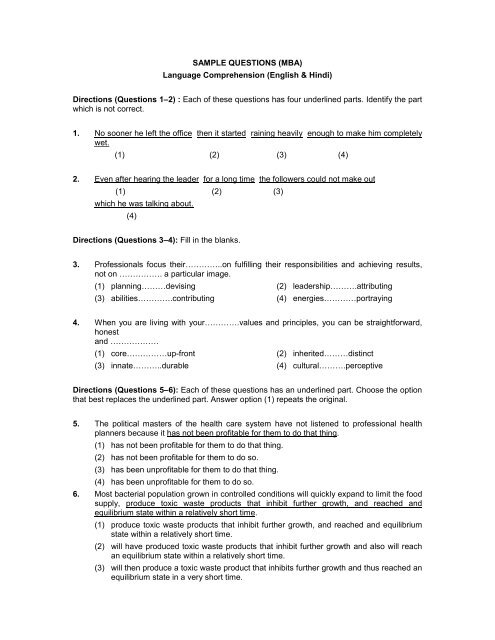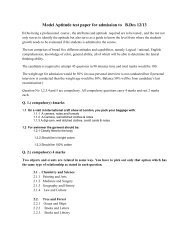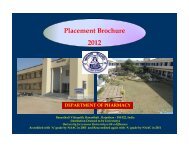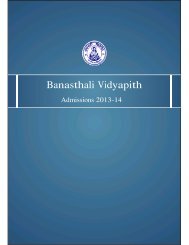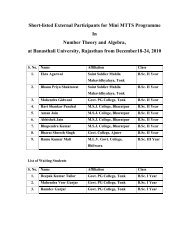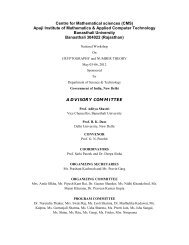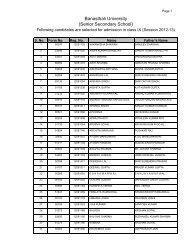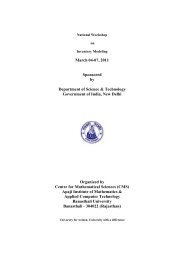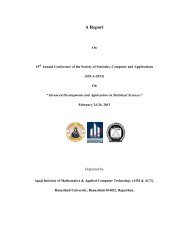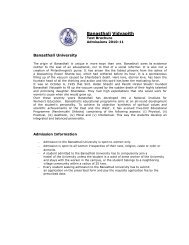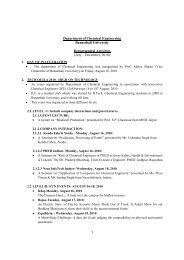SAMPLE QUESTIONS (MBA) Language Comprehension (English ...
SAMPLE QUESTIONS (MBA) Language Comprehension (English ...
SAMPLE QUESTIONS (MBA) Language Comprehension (English ...
Create successful ePaper yourself
Turn your PDF publications into a flip-book with our unique Google optimized e-Paper software.
<strong>SAMPLE</strong> <strong>QUESTIONS</strong> (<strong>MBA</strong>)<br />
<strong>Language</strong> <strong>Comprehension</strong> (<strong>English</strong> & Hindi)<br />
Directions (Questions 1–2) : Each of these questions has four underlined parts. Identify the part<br />
which is not correct.<br />
1. No sooner he left the office then it started raining heavily enough to make him completely<br />
wet.<br />
(1) (2) (3) (4)<br />
2. Even after hearing the leader for a long time the followers could not make out<br />
(1) (2) (3)<br />
which he was talking about.<br />
(4)<br />
Directions (Questions 3–4): Fill in the blanks.<br />
3. Professionals focus their…………..on fulfilling their responsibilities and achieving results,<br />
not on ……………. a particular image.<br />
(1) planning………devising (2) leadership……….attributing<br />
(3) abilities………….contributing (4) energies…………portraying<br />
4. When you are living with your………….values and principles, you can be straightforward,<br />
honest<br />
and ………………<br />
(1) core……………up-front (2) inherited………distinct<br />
(3) innate………..durable (4) cultural……….perceptive<br />
Directions (Questions 5–6): Each of these questions has an underlined part. Choose the option<br />
that best replaces the underlined part. Answer option (1) repeats the original.<br />
5. The political masters of the health care system have not listened to professional health<br />
planners because it has not been profitable for them to do that thing.<br />
(1) has not been profitable for them to do that thing.<br />
(2) has not been profitable for them to do so.<br />
(3) has been unprofitable for them to do that thing.<br />
(4) has been unprofitable for them to do so.<br />
6. Most bacterial population grown in controlled conditions will quickly expand to limit the food<br />
supply, produce toxic waste products that inhibit further growth, and reached and<br />
equilibrium state within a relatively short time.<br />
(1) produce toxic waste products that inhibit further growth, and reached and equilibrium<br />
state within a relatively short time.<br />
(2) will have produced toxic waste products that inhibit further growth and also will reach<br />
an equilibrium state within a relatively short time.<br />
(3) will then produce a toxic waste product that inhibits further growth and thus reached an<br />
equilibrium state in a very short time.
(4) produce toxic waste products that inhibit further growth and reach equilibrium.<br />
Directions (Questions 7–8) : Each question has a group of sentences marked A, B, C, and D.<br />
Arrange these to form a logical sequence.<br />
7. A We tend to see the similarity within a category as being more important, and the<br />
similarity between different categories as being less important, then either actually is.<br />
B Given a small amount of information about a person, we are ready to classify them as<br />
a member of a particular group, and then to infer all kinds of additional facts about<br />
them, as if all members of the group were the same in most respects.<br />
C Our tendency to classify and label everything can lead us into the error of seeing the<br />
word as made up of only those categories for which we have names.<br />
D Expecting too much of the descriptive power of languages is itself a serious cause of<br />
distorted thinking.<br />
(1) DBAC (2) DCBA (3) BDAC (4) BCDA<br />
8. A Some of us, as a result, gain an overall impression of people as either all good or all<br />
bad, making further assumptions on this basis.<br />
B An example of the assumption some patients make that doctors with a good “bedside<br />
manner” are also more technically competent as others who do not relate as well to<br />
their patients.<br />
C This is what the psychologists refer to as halo effect.<br />
D We have a strong tendency of associate positive attributes with other positive<br />
attributes and negative ones with each other.<br />
(1) DABC (2) DCBA (3) DBCA (4) DACB<br />
funsZ'k funsZ'k % % bl iz'u esa fn;s x;s 'kCn dk 'kqö :i crk;saA<br />
9- 'kh";<br />
(1) 'kh'; (2) f'k"; (3) f'k'; (4) 'kh'k;<br />
funsZ'k funsZ'k % % bl iz'u esa fn;s x;s 'kCn ds i;kZ;okph 'kCn crkvksA<br />
10. vj.;<br />
(1) fxjkoV] iru] v/ksxfr (2) dkuu] ou] taxy<br />
(3) vuy] vkx] ikod (4) lq/k] veh] lkse<br />
funZs'k funZs'k % % bl iz'u esa nh x;h yksdksfDr dk vFkZ crkvksA<br />
11. va/ksa esa dkuk jktk<br />
(1) dksf'k'k djuk<br />
(2) jksc ekuuk<br />
(3) vPNs dke dk ifj.kke vPNk gksrk gS<br />
(4) xaokjksa esa lk/kj.k f'kf{kr
funZs'k funZs'k funZs'k % % fuEufyf[kr fn;s x;s iz'u dk okD; v'kqö gSA blds uhps fn;s x;s pkj okD;ksa esa tks<br />
okD; 'kq¼ gS] og crkvksA<br />
12. ekrk&firk dk lsok djuk O;fDr ek=k dk /akeZ gSA<br />
(1) ekrk&firk dk lsok djuk O;fDr ek=k dh /keZ gSA<br />
(2) ekrk&firk dh lsok djuk O;fDr ek=k dk /keZ gSA<br />
(3) ekrk&firk dh lsok djuk O;fDr ek=k dh /keZ gSA<br />
(4) ekrk&firk dh lsok djuk O;fDr ek=k dk v/keZ gSA<br />
Mathematical Skills<br />
13. The population of a village 3 years ago was 16000. Every year, it decreases at the rate of<br />
5% p.a. due to migration to cities. Find its present population.<br />
(1) 13234 (2) 13435 (3) 13718 (4) 13879<br />
14. A laborer has been appointed for 30 days on the condition that he will get Rs 74 per day<br />
and if he is absent he has to pay Re1 per day. At the end of the month he receives Rs<br />
1845/-. For how many days was he absent ?<br />
(1) 4 days (2) 5 days (3) 6 days (4) 7 days<br />
15. The mean and standard deviation of 20 observations are found to be 10 and 2 respectively.<br />
On rechecking it was found that an observation 8 was incorrect. Calculate the correct mean<br />
when the wrong item is omitted.<br />
(1) 9.8 (2) 10.1 (3) 10.4 (4) 10.7<br />
16. A building worth Rs 13300 is constructed on a plot of land worth Rs 72900. After how many<br />
years will the value of both be the same, if the land appreciates at 10 % p.a. and building<br />
depreciates at 10 % p.a.?<br />
(1) 3 yrs (2) 4 yrs (3) 5 yrs (4) 6 hrs<br />
17. A circus artist is climbing a 20 m long rope, which is tightly stretched and ties from the top<br />
of a vertical pole to the ground. Find the height of pole if the angle made by the rope with<br />
the ground level is 30 °?<br />
(1) 10 m (2) 12 m (3) 15 m (4) 18 m<br />
18. The area of a circle inscribed in an equilateral triangle is 154 cm 2<br />
. Find the perimeter of the<br />
triangle.<br />
(1) 70 cm (2) 71.4 cm (3) 72.7 cm (4) 73.6 cm<br />
19. A rectangle reservoir is 120 m long and 75 m wide. At what speed per hour must water flow<br />
into it through a square pipe of 20 cm wide so as the water rises by 2.4 m in 18 hrs?<br />
(1) 25 km/hr (2) 30 km/hr (3) 36 km/hr (4) 48 km/hr
20. Find the sum of 20 terms of the AP 1, 4, 7, 10 …………<br />
(1) 580 (2) 584 (3) 587 (4) 590<br />
21. The average height of 30 students of a class was 150 cm. It was detected later that 165 cm<br />
was wrongly copied as 135 cm for computing the mean. Find the correct mean.<br />
(1) 150.4 cm (2) 150.75 cm (3) 151 cm (4) 151.2 cm<br />
Data Analysis & Sufficiency<br />
Directions (Questions 22–23): The graph given below shows the number of employees joining a<br />
Call Center and leaving during the period 2000 to 2006. The total number of employees at the<br />
end of 1999 was 1500. Study the graph and answer questions that follow.<br />
350<br />
300<br />
250<br />
200<br />
150<br />
100<br />
50<br />
0<br />
250<br />
175<br />
220<br />
185<br />
195 205<br />
185<br />
190<br />
325<br />
195<br />
195<br />
162<br />
2000 2001 2002 2003 2004 2005 2006<br />
22. What is the total number of employees at the end of 2004?<br />
250<br />
232<br />
Joining<br />
Leaving<br />
(1) 1735 (2) 1730 (3) 1715 (4) 1705<br />
23. What is the approximate percentage increase of employees from 2001 to 2006 ?<br />
(1) 10% (2) 12% (3) 8% (4) 14%<br />
Directions (Questions 24–25) : The following graphs show the percentage of different models of<br />
cars produced by an Automobile company in two successive years. The total number of cars<br />
produced in 2001 and 2002 is 42,980 and 48,640 respectively. Study the graphs carefully and<br />
answer the questions that follow.<br />
F<br />
22%<br />
E<br />
27%<br />
2001<br />
A<br />
20%<br />
D<br />
15%<br />
B<br />
6%<br />
C<br />
10%<br />
24. The number of A model car in 2002 was approximately what percentage of A model car<br />
produced in 2001?<br />
F<br />
21%<br />
E<br />
27%<br />
2002<br />
D<br />
9%<br />
A<br />
22%<br />
B<br />
10%<br />
C<br />
11%
(1) 115 (2) 140 (3) 125 (4) 130<br />
25. If the production of D model cars in 2002 was 5000, what would be its approximate<br />
percentage in the company ?<br />
(1) 10 (2) 12 (3) 14 (4) 16<br />
Directions (Questions 26–27) : The bar graph given below show per kg price of cereals for the<br />
months of March to August in a certain year. Study the graph and answer the questions that<br />
follow.<br />
30<br />
25<br />
20<br />
15<br />
10<br />
5<br />
0<br />
22.25<br />
9.75<br />
25<br />
18.25 18<br />
10<br />
23.5<br />
10.5<br />
27.5<br />
24.75<br />
22.5<br />
20 19.25 18.5 19<br />
8.4<br />
11.5<br />
March April May June July August<br />
11<br />
Rice<br />
Wheat<br />
Pulses<br />
26. What is the percentage of increase in the price of rice from March to June ?<br />
(1) 20% (2) 20.5% (3) 25.43% (4) 23.60%<br />
27. Price of which month is closest to the average price of six months in the case of wheat ?<br />
(1) April (2) May (3) July (4) August<br />
Directions (Questions 28–30) : Each of these problems consists of a question followed by two<br />
statements numbered I and II. You have to decide whether the data provided in the statements<br />
are sufficient to answer the question. Choose your answer as<br />
(1) if the data in statement I alone are sufficient to answer the question, while the data in<br />
statement II alone are not sufficient to answer the question.<br />
(2) if the data in statement II are sufficient to answer the question, while the data in statement I<br />
alone are not sufficient to answer the question.<br />
(3) if the data even in both statements I and II together are not sufficient to answer the<br />
question.<br />
(4) if the data in both statements I and II together are necessary to answer the question.<br />
28. Find a two-digit number.<br />
I. The difference between the digits of a two-digit number is 1.<br />
II. The digit at unit’s place of a number is 20% less than the digit at ten’s place.<br />
29. Which newspaper has the maximum circulation in Delhi ?<br />
I. 2 lakh copies of newspaper X are sold in Delhi while the circulation of newspaper Y is<br />
estimated at 3 lakh.<br />
II. The circulation of newspaper Y is 55 % of the total circulation of newspapers.<br />
30. How is X related to Y?<br />
I. Y is the brother of X.<br />
II. X is the mother of Z.
Intelligence & Critical Reasoning<br />
Directions (Questions 31–32) : Select from the answer choices an appropriate term to replace<br />
the question mark and continue the sequence of the series.<br />
31. Z, X, U, Q, L, ?<br />
(1) K (2) I (3) F (4) G<br />
32. BDC, EGF, HJI, KML, ?<br />
(1) PQS (2) MPO (3) NPO (4) QST<br />
Directions (Questions 33–34) : In the following questions, a statement is given followed by two<br />
conclusions, marked I and II. Read the statement and the given conclusions and mark your<br />
answer as<br />
(1) if only I is true.<br />
(2) if only II is true.<br />
(3) if both I and II are true.<br />
(4) if none of the given conclusions is true.<br />
33. Statement : All doctors are intelligent. Some women are doctors.<br />
Conclusions : I. All intelligent people are women.<br />
II. Some women are intelligent.<br />
34. Statement : All teachers in my school are courteous. Bimla is not<br />
courteous.<br />
Conclusions : I. Bimla is not a teacher in my school.<br />
II. Bimla must learn to be courteous.<br />
Directions (Questions 35–36) : Read the following information and answer the given questions.<br />
Seven students P, Q, R, S, T, U and V take a series of tests. No two students get the same<br />
marks. V always scores more than P. P always scores more than Q. Each time either R<br />
scores the highest and T gets the least, or alternatively S scores the highest and U or Q<br />
scores the least.<br />
35. If S is ranked sixth and Q is ranked fifth, which of the following can be true ?<br />
(1) V is ranked first or fourth.<br />
(2) R is ranked second or third.<br />
(3) P is ranked second or fifth.<br />
(4) U is ranked third or fourth.<br />
36. If R gets most, V should be ranked not lower than<br />
(1) Second (2) Third (3) Fourth (4) Fifth<br />
Directions (Questions 37–38) : In each of these questions a related pair of words in capital<br />
letters is followed<br />
by four pairs of words. Select the pair that expresses the relationship that is most similar to that of<br />
the<br />
capitalised pair.<br />
37. ARDUOUS : DIFFICULT<br />
(1) Pest : Genial (2) Cleave : Resign (3) Pivot : Axis (4) Inapt :<br />
Facile
38. OMINOUS : AUSPICIOUS<br />
(1) Dogma : Notion (2) Unusual : Strange<br />
(3) Register : Embody (4) Feeble : Forceful<br />
Directions (Questions 39–40) : Each of these questions has a statement followed by two<br />
arguments numbered I and II. Decide which of the two arguments is a ‘strong’ argument. Give<br />
your answer as<br />
(1) if only argument I is strong.<br />
(2) if only argument II is strong.<br />
(3) if neither I nor II is strong.<br />
(4) if both I and II are strong.<br />
39. Statement : Should cottage industries be encouraged in rural areas?<br />
Arguments : I. Yes. Rural people are creative.<br />
II. Yes. It would help to solve the problem of<br />
unemployment to some extent.<br />
40. Statement : Should education be made compulsory for all children up to<br />
the age of 14?<br />
Arguments : I. Yes. This will help to eradicate the system of forced<br />
employment of these children.<br />
II. Yes. This would improve the standard of living.<br />
General Awareness on Current Affairs<br />
41. In which country did Lakshmi Mittal begin his first operations ?<br />
(1) Nigeria (2) Mexico (3) Indonesia (4) Tanzania<br />
42. Which international brand had an ad campaign - ‘Tomorrow is mine’ ?<br />
(1) Reebok (2) Adidas (3) Puma (4) Nike<br />
43. LG is big name in electronics. What does LG stand for ?<br />
(1) Lucky Goldstar (2) Lucky Gnome (3) Lotus Goldstar (4) Lotus<br />
Gnome<br />
44. Which of the following companies was bought over by the Chinese firm Lenovo?<br />
(1) IBM (2) Dell (3) HP (4) Canon<br />
45. Which business or media group has a majority stake in the financial daily Business<br />
Standard ?<br />
(1) Kotak Mahindra (2) Reliance (Mukesh Ambabi Group)<br />
(3) Anand Bazar Patrika (4) Eenaadu<br />
46. With which brand would you associate the line – Kal Tumhara Hai ?<br />
(1) Compaq (2) HP (3) Dell (4) Acer
47. Which business house got the contract for Mumbai’s metro project ?<br />
(1) Aditya Birla Group (2) Reliance (Anil Ambani)<br />
(3) Jet Airways (4) Infosys<br />
48. Who among the following are NOT eligible for electing the President of India ?<br />
(1) Members of the Lok Sabha (2) Members of the Rajya Sabha<br />
(3) Members of the Vidhan Sabha (4) Members of the Supreme Court<br />
49. Imperial Bank was nationalized in 1955. What was it renamed ?<br />
(1) The State Bank of India (2) Canara bank<br />
(3) Bank of India (4) The Reserve Bank of India<br />
50. Aviva Life Insurance India is a joint venture between Aviva and which other company ?<br />
(1) Dr. Reddy’s Laboratories (2) Dabur<br />
(3) Ranbaxy (4) Hamdard


